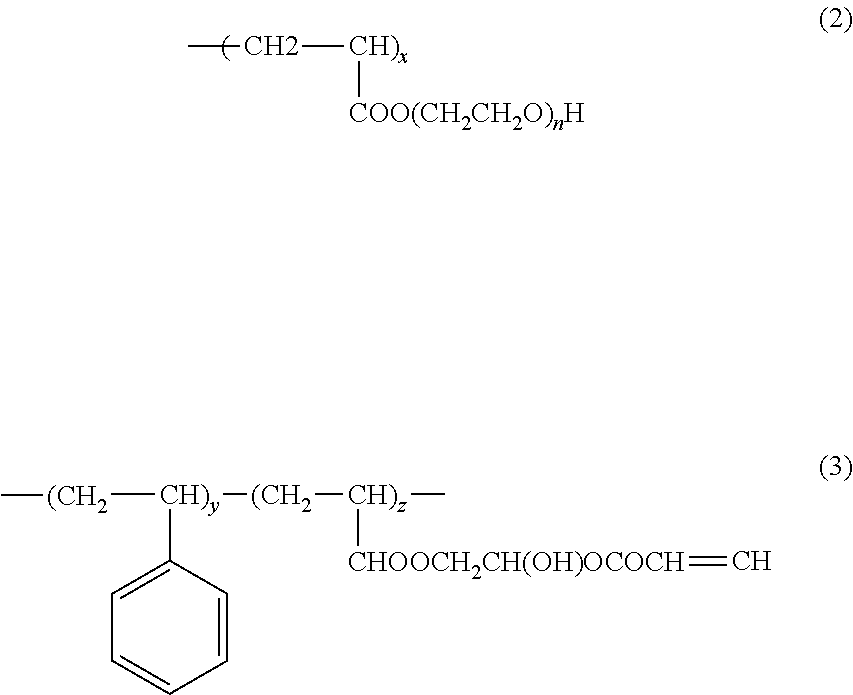Photopolymerizable polymer micelle, method of producing the same, and ink composition containing photopolymerizable polymer micelle
a polymer micelle and polymer micelle technology, applied in the field of photopolymerizable polymer micelle, can solve the problems of insufficient print density, inability to provide sufficient print density, and inability to provide sufficient print density, and achieve excellent photopolymerization properties, excellent resistance to solvents, and free from rapid increase of viscosity
- Summary
- Abstract
- Description
- Claims
- Application Information
AI Technical Summary
Benefits of technology
Problems solved by technology
Method used
Image
Examples
synthetic example 1
1. Synthesis of Polyethylene Glycol Atom Transfer Radical Polymerization (ATRP) Macroinitiator
[0120]Poly(ethylene glycol)monomethyl ether (number average molecular weight of 2000) of 10 g (0.005 mol) and triethylamine of 1.0 g (0.01 mol) were dissolved into anhydrous tetrahydrofuran (THF) of 70 mL. The resultant solution was slightly cooled in an ice bath, and 2-bromoisobutyryl bromide of 4.3 mL (0.035 mol) was slowly added to the resultant product. Then, the solution was warmed to room temperature and was then agitated for 24 hours. The resultant mixed solution was added to water, and then the resultant product was subjected to an extraction process by using methylene chloride. The produced extract was washed by using a hydrochloric acid solution of 1 mol / L and a sodium hydroxide solution of 1 mol / L in sequence. Subsequently, the resultant product was dried on magnesium sulfate, and then a solvent was removed under reduced pressure. The resultant crud product was dissolved in methy...
synthetic example 2
1. Synthesis of Polyethylene Glycol ATRP Macroinitiator
[0126]The same procedures as employed in the synthesis example 1 were similarly employed.
2. Synthesis of Poly(ethylene glycol)-poly(styrene-co-acrylic acid)
[0127]N,N,N′,N′,N″,N″-pentamethyldiethylenetriamine of 1.1 equivalents, copper (I) bromide of 1.1 equivalents, styrene of 5 equivalents, and acrylic acid of 5 equivalents were dissolved into THF. The polyethylene glycol ATRP macroinitiator of 1 equivalent was added to the resultant solution. The resultant product was subjected to a degassing process by using argon gas at room temperature for a time period that was in the range from 15 to 20 minutes. Subsequently, the resultant product was heated at a temperature of 60° C. for eight hours. Then, the resultant product was added to THF containing 10% methanol. A precipitated polymer was filtrated on silica gel, thereby removing copper bromide. Furthermore, the produced polymer was dialyzed against water for 48 hours and was then...
PUM
| Property | Measurement | Unit |
|---|---|---|
| wavelength range | aaaaa | aaaaa |
| temperature | aaaaa | aaaaa |
| particle diameter | aaaaa | aaaaa |
Abstract
Description
Claims
Application Information
 Login to View More
Login to View More - R&D
- Intellectual Property
- Life Sciences
- Materials
- Tech Scout
- Unparalleled Data Quality
- Higher Quality Content
- 60% Fewer Hallucinations
Browse by: Latest US Patents, China's latest patents, Technical Efficacy Thesaurus, Application Domain, Technology Topic, Popular Technical Reports.
© 2025 PatSnap. All rights reserved.Legal|Privacy policy|Modern Slavery Act Transparency Statement|Sitemap|About US| Contact US: help@patsnap.com


